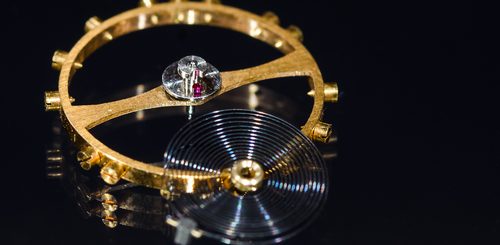The Evolution of Balance Springs Within Watches

One of the most fascinating components in modern watches is the balance spring, as it serves as the heart. Aside from the aesthetics, which most watch enthusiasts love, the miniature spring and its wheel have multiple functions, giving the watch a quality which is virtually organic.
Balance Spring Origins
The very first balance spring was introduced between 1660 and 1675. Prior to its development most watches and clocks used foliots and balance wheels. The trouble with these components is that they had great sensitivity to driving force fluctuations, which could cause the clock or watch to slow down as a result of their mainspring unwinding. The balance spring solved this problem, because not only did it eliminate fluctuation sensitivity, but it also greatly increased the accuracy of clocks overall, from a few hours daily to as little as ten minutes for each day. However, the earliest balance springs were rudimentary as they only offered a small number of turns.
The original balance springs were often accompanied by a regulator, which incorporated the worm drive. Regulators such as the Tompion used curb pins which were positioned on a tooth rack which was semicircular, and which could be adjusted through the fitting of the key into the cog which allowed it to be turned. More advanced regulators would later use a lever which was pivoted concentrically with a wheel that was balanced, and would eventually phase out the Tompion by the 19th century.
Materials Used In Balance Spring Construction
Various materials have been used in balance springs over the years. Originally, steel was the most popular, but because no tempering and hardening process was used, the springs would usually weaken, with the watch failing to accurately tell time. Other watchmakers experimented with gold, which solved the corrosion issue, but the gradual weakening which was seen with steel remained. Eventually the steel started being tempered, which made it the preferred material up to the twentieth century.
By 1833 watchmakers begin using glass, which was far less susceptible to heat than metals such as steel. It also lowered the cost and was not prone to rust. However, the trouble with glass was that not only was it costly to produce, it was challenging to work with, and many felt the resulting balance spring would be too fragile. Most of these issues were resolved with the development of fiber optics and fiber glass.
How Temperature Effects Balance Springs
Watches are machines which are greatly susceptible to temperature fluctuations. In fact, in early timepieces both the balance spring and wheel could easily be effected. Although early watchmakers made note of this phenomenon, due to technological limitations they didn’t have many solutions to it. The issue was eventually solved with the advent of marine chronometers, which utilized a phenomenon called compensation curb (which is a type of bimetallic thermometer) which alters the length of a balance spring dependent on temperature.


